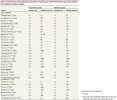Bubbleblower
Well-Known Member
- Relationship to Diabetes
- Type 1.5 LADA
Does it need to have a link to COVID to proof OW and obesity cause type 1 diabetes?This is has no limk to covid (the data is from before the pandemic) and is for young adults not children
Here is one for young children: Obesity, increased linear growth, and risk of type 1 diabetes in children
A 10% unit increment in relative weight was associated with a 50-60% increase in the risk of type 1 diabetes before 3 years of age and a 20-40% increase from 3 to 10 years of age. The increase in risk of type 1 diabetes for 1 SD score increment in relative height was 20-30%. Obesity (relative weight > 120%) after 3 years of age was associated with a more than twofold risk of developing type 1 diabetes.
That is my favorite part 🙂The ‘accelerator hypothesis’ [29]
suggests that both type 1 and type 2 diabetes are caused by
insulin resistance set against various genetic backgrounds that
affect the rate of loss of beta cells and the disease phenotype.
According to this hypothesis, the increasing demand for insulin
renders the beta cells more antigenic, and thus accelerates
their loss through autoimmune injury.




